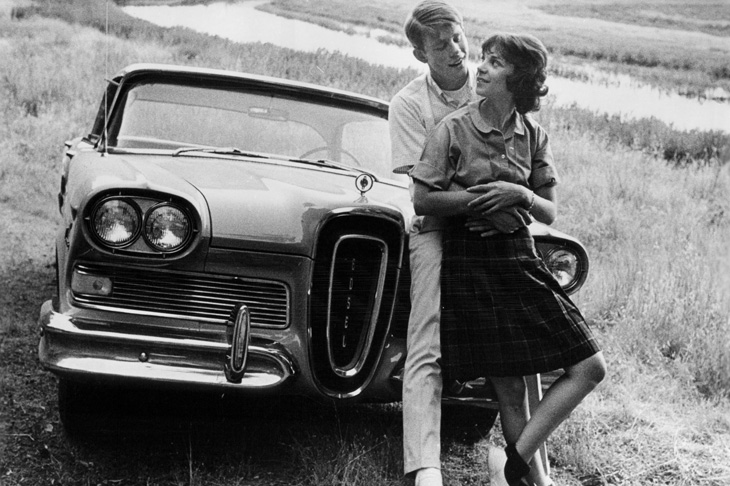In 1973, four years before he disappeared down the Star Wars rabbit hole, George Lucas directed the film American Graffiti, eulogising his days as a teenage car fanatic in Modesto, California; parking at drive-ins, hot-rodding and cruising for dates. This vanished world was only a decade away —‘Where were you in 62?’ said thepublicity — the equivalent of someone today getting dewy-eyed about 2007. Yet the clashes and strife of the late 1960s in mainland America and the deepening quagmire of the Vietnam War had already made those days look like an age of lost innocence. The film was an international hit, but in October that year Opec’s oil embargo quadrupled the price per barrel, putting any number of nails in the coffin of cheap motoring and jacked-up jalopies.
Gary S. Cross, a University of Chicago professor, came of age around the same time as Lucas, and cites American Graffiti several times in this book. His time frame stretches from the earliest days of motoring in the US up to the present, although the scene and the circumstances which supported it moved into serious decline after the 1970s, once computer-designed identikit boxes took the place of the Detroit dream machines of earlier decades. Those were the days when, according to one of the many veterans he quotes, ‘the cars were the coolest, the chicks the bitchingest; the guys were bad-ass SOBs’.
As Cross points out, in the first half of the 20th century, ‘Americans were curiously tolerant of very young people driving’; indeed, California used to issue licences to 14-year-olds. What could possibly go wrong?
Among the most informative and enjoyable parts of this book are the very large number of reminiscences Cross has gathered from veteran car enthusiasts, generally identified by their home town and date of birth. He is particularly good at evoking the early days of the prewar era, when secondhand virtual wrecks could be picked up for a few dollars and customised into something that would leave most other road users trailing in the dirt. The origins of pioneer hot-rodders such as Harry Westergard, George and Sam Barris or Ed ‘Big Daddy’ Roth are well described, as are a selection of terms for the various modifications they could achieve — chopping, sectioning, frenching, lowering and channelling.
Perhaps inevitably for a 21st-century academic book, this tends to judge the car enthusiasts by modern PC standards, which is as about as useful as wondering why there were not more transgender people represented at the Charge of the Light Brigade, since any US grouping of that time could be similarly criticised: politicians, housewives, chartered accountants, even college professors.
In a study devoted to young people and cars, it is a shame that the key role of music in building the myth and celebrating the lifestyle, while pouring out of a million dashboard radios, is not more fully addressed. Equally, cinematic attempts to cash in on the trend, such as Hot Rod Gang (1958), are generally namechecked but mostly left unexamined.
American Graffiti featured a guest appearance from the legendary DJ Wolfman Jack, plus a barrage of carefully chosen 1950s hits, and from the earliest days of motoring, America had celebrated its car obsession in song, not least the romantic possibilities of parking in lovers’ lane. One of Cross’s chapters is entitled ‘Cruising and Parking’, so to make no mention of a particular well-known Gene Vincent song (helpfully entitled ‘Cruising’) seems like a missed opportunity.
By the same token, as early as 1909 Ada Jones advised fellow females to ‘Keep Away From the Man Who Owns An Automobile’ (1909) because ‘you must kiss him or get out and walk’, but neither this or many other pre-second world war songs celebrating what was euphemistically known as ‘parking’ are mentioned here.
Nor is what is usually regarded as the first ever rock’n’roll record, Rocket 88 by Jackie Brenston and His Delta Cats (1951) — an unstoppable powerhouse of a tune about the joys of speeding along in an Oldsmobile 88. Chuck Berry is mentioned a few times, yet it is simply wrong to state that the historic highway Route 66 was ‘made famous in the 1950s by a popular car-themed TV show’. The programme actually ran from 1960 to 1964, but it was Bobby Troup’s million-selling song of that name — initially recorded in 1946 by the Nat Cole Trio then covered by Bing Crosby, Chuck Berry, the Rolling Stones and countless others — which first drilled 66 into the public consciousness.
This is a valuable book in terms of its original research and the growth of car customising and hot-rodding, but it would have been good to hear more of the wider cultural manifestations of the days when, in the immortal words of Philippa Fallon’s beat poet character in the cars-and-drugs exploitation film High School Confidential (1958), you wanted to ‘tool a fast short’ and ‘swing with a gassy chick’.






Comments